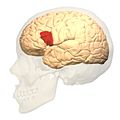| Brodmann area 44 | |
|---|---|
 | |
 | |
| Details | |
| Artery | middle cerebral artery |
| Identifiers | |
| Latin | area opercularis |
| NeuroLex ID | birnlex_1776 |
| FMA | 68641 |
| Anatomical terms of neuroanatomy | |
Brodmann area 44, or BA44, is part of the frontal cortex in the human brain. Situated just anterior to premotor cortex (BA6) and on the lateral surface, inferior to BA9.
Contents
This area is also known as pars opercularis (of the inferior frontal gyrus), and it refers to a subdivision of the cytoarchitecturally defined frontal region of cerebral cortex. In the human it corresponds approximately to the opercular part of the inferior frontal gyrus. Thus, it is bounded caudally by the inferior precentral sulcus (H) and rostrally by the anterior ascending limb of lateral sulcus (H). It surrounds the diagonal sulcus (H). In the depth of the lateral sulcus it borders on the insula. Cytoarchitectonically it is bounded caudally and dorsally by the agranular frontal area 6, dorsally by the granular frontal area 9 and rostrally by the triangular part of inferior frontal gyrus (Brodmann area 45 BA 45).


